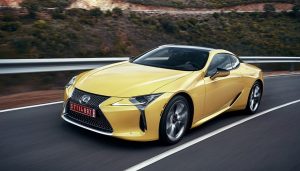
Wide open, the engine gets a little twitchy on the Lexus RC 200t.
2017 Lexus RC Review: A Mean and Unrefined Coupe
As I set out to test the Lexus RC, I wondered which side of Lexus I’d see.
Lexus has a mixed record when it comes to sporty coupes. On the one hand, it made the SC, a car that was impressive in its first generation. Then the SC became a bloated image-mobile, instead of something truly fun to drive.
I’m of the belief that the Lexus IS for the most part is a bundle of missed opportunities. The car could really help make Lexus more youthful, but instead it’s a half-measure. There’s nothing truly remarkable about the vehicle, no matter the version you get.
It Has Looks
You could call the exterior of the Lexus RC sporty and not be wrong. You could also call it angry, like all modern Lexus vehicles. It screams for you to look at it, with many daring angles crashing together.
I must admit I’m not really a fan of the current Lexus design language. That said, the RC pulls it off best. Unlike some vehicles from the luxury brand, there’s a sense of flowing lines on the coupe, at least overall. Still, I’m not big on the spindle grille, or the headlight accents that look like Nike Swooshes.
Thankfully, the interior doesn’t look angry. It does feature some sporty elements, like contoured seats with big side bolsters. Overall, the layout is clean and modern, which is typical for a Lexus these days. Why that kind of approach isn’t used for the vehicle exteriors – I’ll just stop there.
Does It Deliver?
On paper, the different versions of the Lexus RC seem at least decent, if not impressive. The 200t uses a 2.0-liter four-cylinder engine, fed by a twin-scroll intercooled turbo. It’s like similar setups in other cars, achieving about the same results at 241 hp and 258 lb.-ft. of torque.
A 3.5-liter V-6 is used on the 300 AWD and 350. In the first iteration it puts out 255 hp and 236 lb.-ft. of torque, which is underwhelming for that kind of displacement. In the RC 350 that same V-6 is tuned to produce 306 hp and 277 lb.-ft. of torque, which is better, but not monstrous.
If you really want power, the RC F peaks at 467 hp. Torque is okay at 389 lb.-ft., considering Lexus uses a 5.0-liter V-8 to squeeze that out. Examples with the same size V-8 like the Mustang GT outclass that, enough to make a noticeable difference.
An eight-speed automatic transmission is used for the RC 200t, 350 and F. For the 300 AWD and 350 AWD, a 6-speed automatic is standard.
Where the RC doesn’t seem nearly as impressive is the curb weight. It’s a stout car, with the 200t tipping the scales at 3,737 pounds. Other models are heavier, and the RC F lumbers around the 4,000-pound mark.
Lexus says the 200t dashes from 0-60 mph in 7.3 seconds. The RC 300 AWD shaves off an entire second, while the 350 AWD comes in at 6 seconds flat. With the RC 350, the car scoots even quicker at 5.8 seconds. Thanks to the far more powerful V-8, the RC F does it in a brutal 4.4 seconds.
Lexus uses double wishbones for the front suspension on all models, and a multilink configuration in the rear. Electric power steering with a rack-and-pinion setup is also standard. Pumping up handling response for the RC F is an adaptive variable suspension, plus beefier shock absorbers and stabilizer bars. An F Sport mode for the steering makes it more sensitive, which you can select for situations like track runs.
Driving Impressions
I was able to test out the RC 200t, 350 AWD and F. There were some distinct differences among the three.
The 200t not only is the slowest of the bunch, at WOT the engine gets twitchy. The little four-banger screams and howls like it’s being tortured as you push it. Handling for everyday scenarios is decent, but if you push it in a turn, the rear breaks free easily. Overall, this combines for a less-than-inspiring experience.
With the RC 350 AWD handling is markedly better, especially when pushed in curves, as the all-wheel-drive system makes automatic corrections. Still, when compared to Teutonic rivals and even the Cadillac ATS, its handling tends to be more sloppy. Thanks to the dual banks of cylinders, the engine really puts on an audible show when you push it. But I found it to be a lot of sabre rattling and not nearly as much substance.
The 350 AWD reminds me of the Lexus GS F, which isn’t a bad car, but it doesn’t quite reach the same level of road presence as the German rivals. It’s like getting a nice seafood dinner in the Rockies, versus on the coast at a restaurant situated on the pier.
The RC F feels like a completely different car. Acceleration is explosive. The exhaust note is brutal. Pushing down the accelerator is addictive. When pushed through turns, though, the fun ended there.
Really, the RC F, like its siblings, is more muscle car than anything. It’s sloppy, with too much body roll and imprecise steering, when compared to the raw power pulsating out from under the hood.





